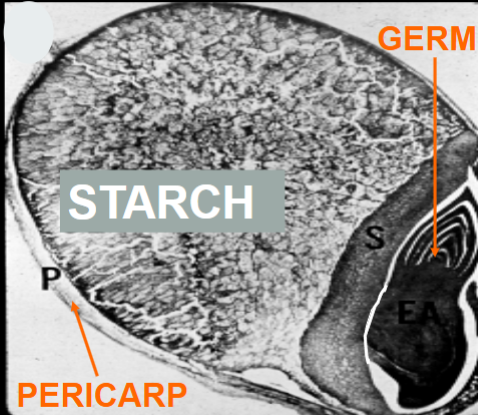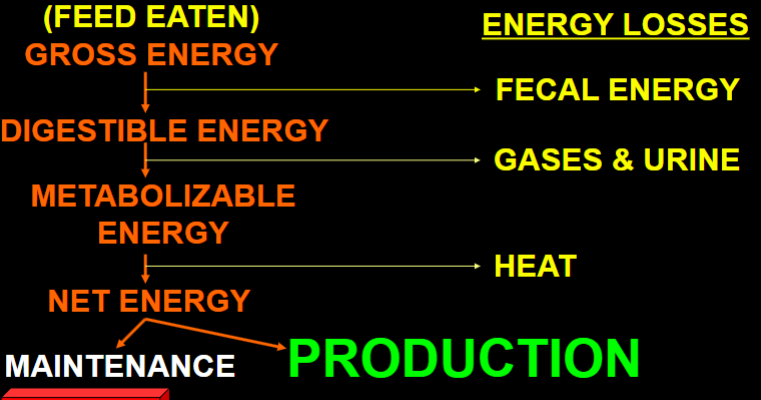Nutrition, Digestion, and Feeds
1/199
There's no tags or description
Looks like no tags are added yet.
Name | Mastery | Learn | Test | Matching | Spaced |
|---|
No study sessions yet.
200 Terms
Nutrition is the science that deals with
food and the nutrients it contains that man and animals must have to live and function
Therefore, man is vitally interested in nutrition for
his own sake
However, the animal scientist or livestock producer is interested in nutrition as it
affects the productivity and thereby the profitability of their animals
The meat animal production chain involves
breeding, feeding, management, and marketing
The single most costly category is
feeding
Therefore, a profitable and efficient production program must
consider the efficient use of feeds
To use the various feeds most intelligently, feeders must not only know the various nutrients feeds contain and the function of those nutrients in the animal body but also
be acquainted with the anatomy of the digestive tract of various species
Feeders must know the physical and chemical processes involved in
the digestion and absorption of various nutrients
Additionally, students can learn much information to allow them to understand better
the nutritional needs of and functions of nutrients in their own bodies
If we selected and use feeds more efficiently, we will
have more net income
A lack of knowledge about nutrition can
produce some poor results in animals
Why are some rations pelleted?
The weight of the piles is the same
Classification of Animal Feeds:
Concentrates
Roughages
Animal Feed: Concentrates are
high in energy, low in fiber, easily digestible
Animal Feed: Concentrates can be _ or _
Carbonaceous, Nitrogenous
Concentrates: Carbonaceous -
low in protein; cereal grain (corn, wheat, oats, sorghum), molasses
Concentrates: Nitrogenous -
high in protein; oil meals (soybean meal, cottonseed meal), fish meal, packing house by-products such as tankage, dairy products
Important in feeding monogastric animals, companion animals
Animal Feeds: Roughages are
high in energy, low in fiber, less digestible than concentrates
Animal Feed: Concentrates can be __ or __
Carbonaceous, Nitrogenous
Roughages: Carbonaceous -
low in protein; mature grass hay, stover, mature cereal grain silage
Roughages: Nitrogenous -
high in protein; legume hay and silage, immature grass hay and silage, growing pasture and silage
Important in feeding ruminant animals (animals who can use the ruffage)

Cross section of a grain kernel
Starch is carbohydrate
Germ is protein
Pericarp needs to be cracked to allow digestion
Nutrients are chemical substances in either mineral or compound form that are
absorbed from the digestive tract into the blood and that function in metabolism of the body
water is the cheapest and
most abundant nutrient
water is absolutely
necessary for life
An animal will die more quickly from lack of water than
from lack of any other nutrient
How can camels go longer (a week or more) without drinking than we can?
They drink more when it is available (have a large storage capacity in the rumen)
They conserve water better (dry species and concentrated urine)
In a hot environment, a camel can lose 27% of its body weight without observable ill effects
Death occurs after loss of
10%-14% of water in the body
Body temperature fluctuates without causing distress; may fall to
93 degrees F at night and rise to 105 degrees F in the daytime
Minerals regulate
body water
Sources of water
Drinking
Ingested - contained in or on feed
Metabolic - derived from breakdown of nutrients
Functions of water
Transport of nutrients and excretions
Chemical reactions and solvent properties
Body temperature regulation (sweat)
Maintenance of shape of body cells
Lubrication and cushioning of joints and organs
You will die most quickly without
water
Proteins are composed of
amino acids (are the building blocks) - 22 amino acids
Each amino acid contains nitrogen
Structure of proteins
amino acids > peptide > polypeptide > protein
Classifications of amino acids
Essential
Non-essential
Classification of amino acids
Essential -
essential to animal; must be supplied in diet because body cannot synthesize them fast enough to meet requirements
Memory code: MATT HILL VP for
methionine, arginine, threonine, tryptophan, histidine, isoleucine, leucine, lysine, valine, and phenylalanine
Classification of amino acids
Non-essential -
are essential to the animal, however they are normally synthesized or are in sufficient quantity in the diet and need not be fed to the animal
Protein analysis - determine Nitrogen content and
multiply by 6.25 (average nitrogen content of proteins is 100/16)
Example of protein analysis - If a feedstuff analyzed 1.92% nitrogen,
1.92 x 6.25 = 12% crude protein
Protein analysis - crude protein and digestible protein
The portion of crude protein that is actually digested is digestible protein
Protein quality vs.
protein quantity
Nonprotein nitrogen (NPN) - urea, biuret
If a substance contains nitrogen that is not a part of amino acids, it is called Nonprotein nitrogen (NPN)
Rumen microbes can use this NPN as the nitrogen source for amino acid MFG
Functions of proteins
Basic structural unit of animal body
Body metabolism - enzymes, hormones, immune antibodies, and hereditary transmission structures are composed of proteins
Energy source; excess will be excreted or stored as fat
protein supplements are
expensive
Carbohydrates: Photosynthesis produces
CHO’s: 6 CO2 + 6 H2O + 673 calories of radiant energy from sunlight (Chlorophyll) > C6H12O6 + 6 O2
Carbohydrates are classified by
the number of simple sugars in the molecule
Carbs: Monosaccharides (C6 H12 O6)
one sugar molecule; examples are glucose, fructose, galactose, mannose
Carbs: Disaccharides (C6 H22 O11)
two sugar molecules; examples are sucrose (glucose + fructose), maltose (glucose + glucose), lactose (glucose + galactose)
Carbs: Trisacchariedes
three sugar molecules; examples are raffinose (glucose + fructose + galactose); bacteria in some animal stomachs can degrade
Carbs: Polysaccharides
many sugar molecules; starch, cellulose, lignin, glycogen. amylopectin
Long chains or branched molecules of several disaccharide subunits
Carbohydrates: Analysis
determine carbohydrate content of a substance by nitrogen free extract (NFE)
Carbohydrates: function
provide energy and heat; excess will be stored as fat or excreted
Carbs are a main
energy source
Structure of Lipids (fats and oils)
composed of fatty acids (saturated and unsaturated) and glycerol
Lipids produces 2.25 times more energy (9 calories per gram) than
proteins or carbohydrates (CHOs) (4 calories per gram)
Fats are solid at room temperature; examples are
lard and beef tallow
Oils are liquid at room temperature; examples are
cottonseed oil and corn oils
Lipids (fats and oils) - Fat analysis - either extraction; fat x 2.25 (9/4 = 2.25)
This caloric value difference (9 vs 4) is the reason people trying to lose weight should eat a low fat diet
But total calories, not just fat calories, determine your loss or gain in weight
About 3,000 calories = 1 pound of weight gain
We determine fat content by ether extraction; lipids are soluble in either
Lipids (fats and oils) - functions
Provide energy; excess will be stored as fat or excreted
Best energy source per gram, if we eat too much it will be stored as fat
Lipids (fats and oils) are sources of
heat, insulation, and protection
Lipids (fats and oils) are carriers for
absorption of fat soluble vitamins (D, E, A, K)
Some skin conditions are caused by
a dietary deficiency of these fatty acids (D, E, A, K)
These 3 fatty acids are unsaturated - one valence
of adjacent carbon atoms are not satisfied by hydrogen atoms
Lipids (fats and oils) - digestion coefficient
(in - out) / in x 100
Lipids: Measurement of energy content of feeds
Digestion coefficient = (amount digested / amount consumed) x 100; you multiple by 100 to get percent digestibility
Lipids: Total digestible nutrients (TDN) =
digestible protein + digestible crude fiber + (digestible fat x 2.25) + nitrogen free extract

Components of energy
Gross energy
digestible energy
metabolizable energy
net energy
Lipids give 2.25 times more energy than
carbs or proteins
Vitamins: functions
organic catalysts in biochemical reactions
Needed in small amounts
Vitamins: Classification
Fat Soluble (carried in fats): Vitamins D, E, A, K
Water Soluble: Vitamin C
Water Soluble B-complex vitamins: Thiamin, Riboflavin, Pantothenic acid, Niacin, Pyridoxine (vitamin B6), Biotin, Folic Acid, Vitamin B12, Choline, Inositol, Para-aminobenzoic acid
Vitamin D
Function: Aids calcium absorption from the gut; humans manufacture this if exposed to sunlight
Deficiency: Can be cause of skeletal diseases such as rickets
Vitamin E
Function: Has antioxidant properties; can help reduce free radicals. Research has shown that this may help delay Alzheimer’s effects
Deficiency: Exudative diathesis
Vitamin A
Function: Proper vision, helps eyesight
Deficiency: Night blindness, shortage can cause blindness by constriction of the optic nerve as it passes through the bones of the skull (nerve grows, but bone doesn’t)
Vitamin K
Function: Necessary for blood clotting
Deficiency: Bleeding, if a pet eats rat poison the vet probably will give a large injection of this
Vitamin C
Function: From citrus fruits, functions in collagen formation
Deficiency: Scurvy
Water Soluble B-complex Vitamins: most of these
vitamins function as coenzymes in oxidative metabolic reactions and prevent several disease conditions
Vitamin Thiamin
Function: Coenzyme
Deficiency: Beriberi, nerve disorder
Vitamin Riboflavin
Function: Coenzyme
Deficiency: Paralysis, curled toe paralysis
Vitamin Pantothenic acid
Function: Coenzyme A
Deficiency: Goose stepping
Vitamin Niacin
Function: Coenzyme
Deficiency: Pellagra, skin eruptions, retarded growth
Vitamin Pyridoxine (vitamin B6)
Function: Coenzyme
Deficiency: Acrodynia, epileptic-like fit
Vitamin Biotin
Function: Coenzyme
Deficiency: Perosis, unclean, hair loss
Vitamin Folic Acid
Function: Oxygen transport
Deficiency: Anemia
Vitamin B12
Function: Only source is meat. Oxygen transport
Deficiency: Anemia, slow growing, rough haircoat, dermatitis
Vitamin Choline
Function: Liver fat metabolism
Deficiency: Liver cirrhosis, spraddled legs
Vitamin Inositol
Function: Lipotrophic action rats
Deficiency: Alopecia
Vitamin Para-aminobenzoic acid
Function: Chick growth stimulant
Deficiency: Graying animal hair
Most B-complex citamins function in
oxidative metabolism
Vitamins are organic
catalysts
If a small amount of a vitamin is good, is a large amount better?
Not necessarily—while small amounts of vitamins are essential, large amounts can be harmful and may lead to toxicity.
What vitamins are toxic in megadoses?
Fat-soluble vitamins A, D, E, and K are most toxic in megadoses because they accumulate in the body and can lead to serious health risks like liver damage, bone fractures, and bleeding disorders.
Do ruminant and non-ruminant animals have the same vitamin requirements?
No, ruminant and non-ruminant animals do not have the same vitamin requirements due to differences in their digestive systems and microbial synthesis capabilities.
Minerals (ash) are inorganic, required by
animals, both plant and animal sources
The balance among minerals sometimes is as
critical as the amount in the diet
Some minerals are components of hormones and
enzymes
For example, zinc is needed for manufacturing of sex hormones
Minerals help main a cell’s
osmotic pressure
Minerals help maintain a correct
acid : base balance
Minerals are needed for
bones and teeth formation